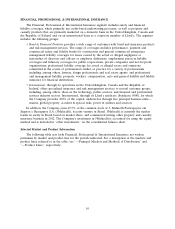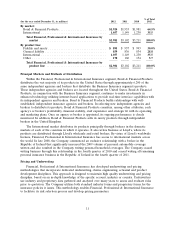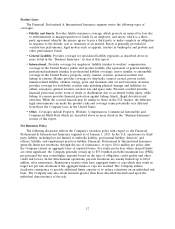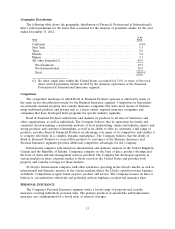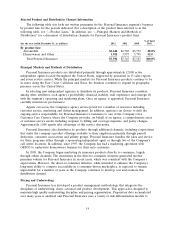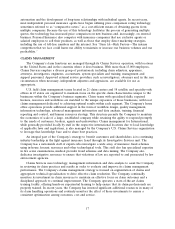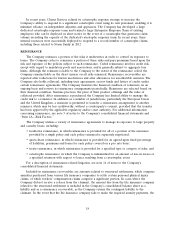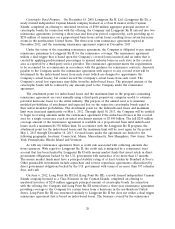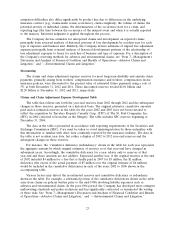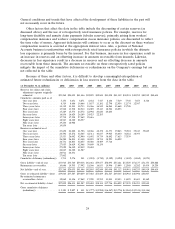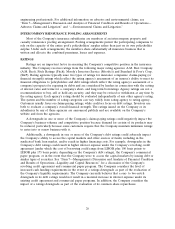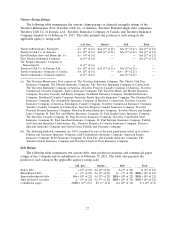Travelers 2012 Annual Report Download - page 29
Download and view the complete annual report
Please find page 29 of the 2012 Travelers annual report below. You can navigate through the pages in the report by either clicking on the pages listed below, or by using the keyword search tool below to find specific information within the annual report.automation and the development of long-term relationships with individual agents. In recent years,
most independent personal insurance agents have begun utilizing price comparison rating technology,
sometimes referred to as ‘‘comparative raters,’’ as a cost-efficient means of obtaining quotes from
multiple companies. Because the use of this technology facilitates the process of generating multiple
quotes, the technology has increased price comparison on new business and, increasingly, on renewal
business. Personal Insurance also competes with insurance companies that use exclusive agents or
salaried employees to sell their products, as well as those that employ direct marketing strategies,
including the use of toll-free numbers and the internet. See ‘‘Item 1A—Risk Factors—The intense
competition that we face could harm our ability to maintain or increase our business volumes and our
profitability.’’
CLAIMS MANAGEMENT
The Company’s claim functions are managed through its Claims Services operation, with locations
in the United States and in the countries where it does business. With more than 13,000 employees,
Claims Services employs a diverse group of professionals, including claim adjusters, appraisers,
attorneys, investigators, engineers, accountants, system specialists and training, management and
support personnel. Approved external service providers, such as investigators, attorneys and, in the rare
circumstances when necessary, independent adjusters and appraisers, are available for use as
appropriate.
U.S. field claim management teams located in 21 claim centers and 58 satellite and specialty-only
offices in 45 states are organized to maintain focus on the specific claim characteristics unique to the
businesses within the Company’s business segments. Claim teams with specialized skills, required
licenses, resources and workflows are matched to the unique exposures of those businesses, with local
claims management dedicated to achieving optimal results within each segment. The Company’s home
office operations provide additional support in the form of workflow design, quality management,
information technology, advanced management information and data analysis, training, financial
reporting and control, and human resources strategy. This structure permits the Company to maintain
the economies of scale of a large, established company while retaining the agility to respond promptly
to the needs of customers, brokers, agents and underwriters. Claims management for International,
while generally provided locally by staff in the respective international locations due to local knowledge
of applicable laws and regulations, is also managed by the Company’s U.S. Claims Services organization
to leverage that knowledge base and to share best practices.
An integral part of the Company’s strategy to benefit customers and shareholders is its continuing
industry leadership in the fight against insurance fraud through its Investigative Services unit. The
Company has a nationwide staff of experts who investigate a wide array of insurance fraud schemes
using in-house forensic resources and other technological tools. This staff also has specialized expertise
in fire scene examinations, medical provider fraud schemes and data mining. The Company also
dedicates investigative resources to ensure that violations of law are reported to and prosecuted by law
enforcement agencies.
Claims Services uses technology, management information and data analysis to assist the Company
in reviewing its claim practices and results in order to evaluate and improve its claims management
performance. The Company’s claims management strategy is focused on segmentation of claims and
appropriate technical specialization to drive effective claim resolution. The Company continually
monitors its investment in claim resources to maintain an effective focus on claim outcomes and a
disciplined approach to continual improvement. The Company operates a state-of-the-art claims
training facility, offering hands-on experiential learning to help ensure that its claim professionals are
properly trained. In recent years, the Company has invested significant additional resources in many of
its claim handling operations and routinely monitors the effect of those investments to ensure a
consistent optimization among outcomes, cost and service.
17





